door MITSUBISHI OUTLANDER 2020 (in English) Manual Online
[x] Cancel search | Manufacturer: MITSUBISHI, Model Year: 2020, Model line: OUTLANDER, Model: MITSUBISHI OUTLANDER 2020Pages: 443, PDF Size: 60.03 MB
Page 369 of 443
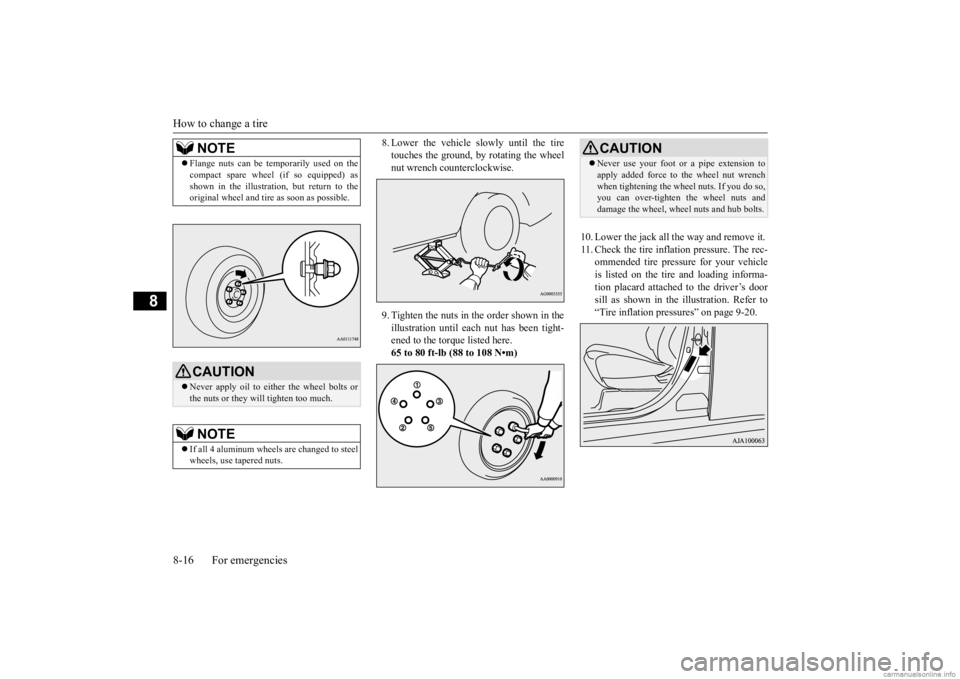
How to change a tire 8-16 For emergencies
8
8. Lower the vehicle slowly until the tire touches the ground, by rotating the wheelnut wrench counterclockwise. 9. Tighten the nuts in the order shown in the illustration until each
nut has been tight-
ened to the torque listed here.65 to 80 ft-lb (88 to 108 N•m)
10. Lower the jack all the way and remove it. 11. Check the tire inflation pressure. The rec-
ommended tire pressure for your vehicleis listed on the tire
and loading informa-
tion placard attached to the driver’s door sill as shown in the illustration. Refer to“Tire inflation pressures” on page 9-20.
NOTE
Flange nuts can be te
mporarily used on the
compact spare wheel (if so equipped) asshown in the illustration, but return to theoriginal wheel and tire as soon as possible.CAUTION Never apply oil to either the wheel bolts or the nuts or they will tighten too much.NOTE
If all 4 aluminum wheels are changed to steel wheels, use tapered nuts.
CAUTION Never use your foot or a pipe extension to apply added force to the wheel nut wrenchwhen tightening the wheel nuts. If you do so,you can over-tighten the wheel nuts and damage the wheel, wheel nuts and hub bolts.
BK0278200US.book 16 ページ 2019年4月10日 水曜日 午前10時59分
Page 376 of 443
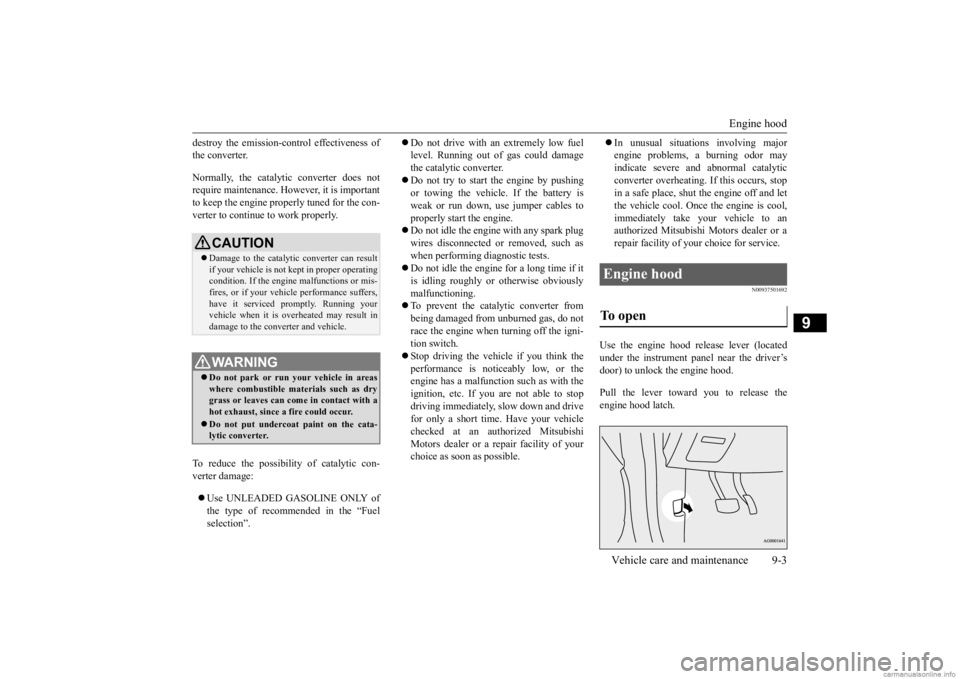
Engine hood
Vehicle care and maintenance 9-3
9
destroy the emission-c
ontrol effectiveness of
the converter. Normally, the catalyti
c converter does not
require maintenance. However, it is important to keep the engine properly tuned for the con- verter to continue to work properly. To reduce the possibili
ty of catalytic con-
verter damage: Use UNLEADED GASOLINE ONLY of the type of recommended in the “Fuelselection”.
Do not drive with an extremely low fuel level. Running out of gas could damagethe catalytic converter. Do not try to start the engine by pushing or towing the vehicle. If the battery isweak or run down, use jumper cables to properly start the engine. Do not idle the engine with any spark plug wires disconnected or removed, such as when performing
diagnosti
c tests.
Do not idle the engine
for a long time if it
is idling roughly or otherwise obviously malfunctioning. To prevent the catalytic converter from being damaged from unburned gas, do not race the engine when turning off the igni-tion switch. Stop driving the vehicle if you think the performance is noticeably low, or theengine has a malfunction such as with the ignition, etc. If you are not able to stop driving immediately,
slow down and drive
for only a short time. Have your vehicle checked at an authorized Mitsubishi Motors dealer or a repair facility of yourchoice as soon
as possible.
In unusual situations involving major engine problems, a burning odor mayindicate severe a
nd abnormal catalytic
converter overheating. If this occurs, stop in a safe place, shut
the engine off and let
the vehicle cool. Once the engine is cool, immediately take your vehicle to an authorized Mitsubishi Motors dealer or arepair facility of your
choice for service.
N00937501692
Use the engine hood release lever (located under the instrument panel near the driver’s door) to unlock the engine hood. Pull the lever toward you to release the engine hood latch.
CAUTION Damage to the catalyti
c converter can result
if your vehicle is not
kept in proper operating
condition. If the engine
malfunctions or mis-
fires, or if your vehi
cle performance suffers,
have it serviced promptly. Running your vehicle when it is
overheated may result in
damage to the converter and vehicle.WA R N I N G Do not park or run your vehicle in areas where combustible materials such as dry grass or leaves can come
in contact with a
hot exhaust, since a fire could occur. Do not put undercoat paint on the cata- lytic converter.
Engine hood To open
BK0278200US.book 3 ページ 2019年4月10日 水曜日 午前10時59分
Page 381 of 443
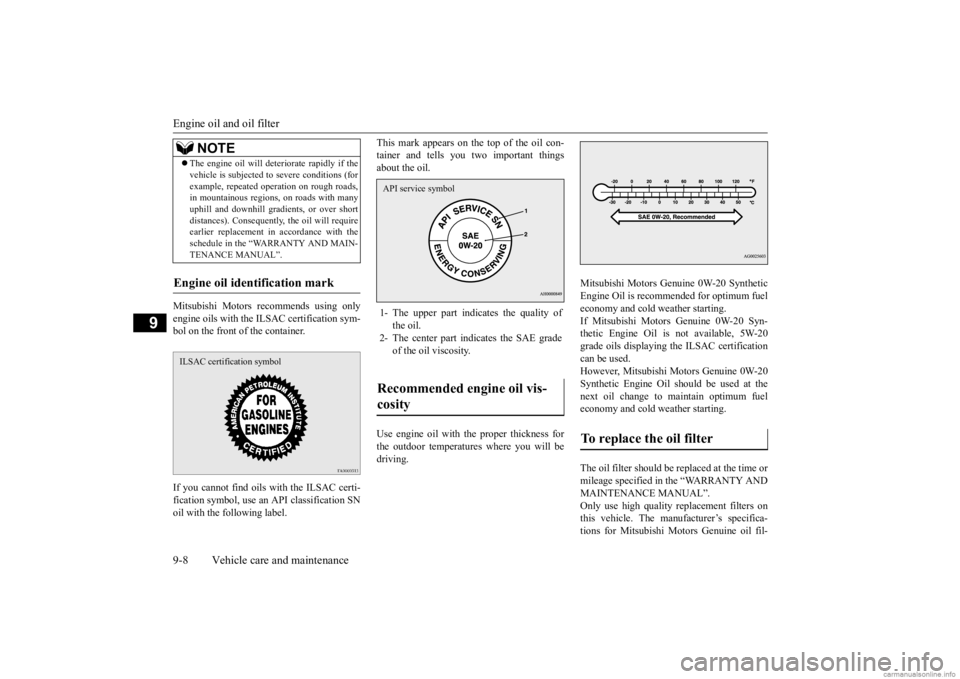
Engine oil and oil filter 9-8 Vehicle care and maintenance
9
Mitsubishi Motors recommends using only engine oils with the
ILSAC certification sym-
bol on the front of the container. If you cannot find oils with the ILSAC certi- fication symbol, use an API classification SN oil with the following label.
This mark appears on the top of the oil con- tainer and tells you two important thingsabout the oil. Use engine oil with the proper thickness for the outdoor temperatures where you will bedriving.
Mitsubishi Motors Genuine 0W-20 Synthetic Engine Oil is recomm
ended for optimum fuel
economy and cold weather starting. If Mitsubishi Motors Genuine 0W-20 Syn- thetic Engine Oil is
not available, 5W-20
grade oils displaying the ILSAC certification can be used. However, Mitsubishi Motors Genuine 0W-20Synthetic Engine Oil s
hould be used at the
next oil change to maintain optimum fuel economy and cold weather starting. The oil filter should be
replaced at the time or
mileage specified in
the “WARRANTY AND
MAINTENANCE MANUAL”. Only use high quality
replacement filters on
this vehicle. The manufacturer’s specifica-tions for Mitsubishi Motors Genuine oil fil-
The engine oil wi
ll deteriorate rapidly if the
vehicle is subjected to
severe conditions (for
example, repeated operation on rough roads,in mountainous regions, on roads with many uphill and downhill grad
ients, or over short
distances). Consequently
, the oil will require
earlier replacement in accordance with the schedule in the “WARRANTY AND MAIN- TENANCE MANUAL”.
Engine oil identification mark
NOTE
ILSAC certification symbol
1- The upper part indicates the quality of
the oil.
2- The center part indicates the SAE grade
of the oil viscosity.
Recommended engine oil vis- cosity API service symbol
To replace the oil filter
BK0278200US.book 8 ページ 2019年4月10日 水曜日 午前10時59分
Page 388 of 443
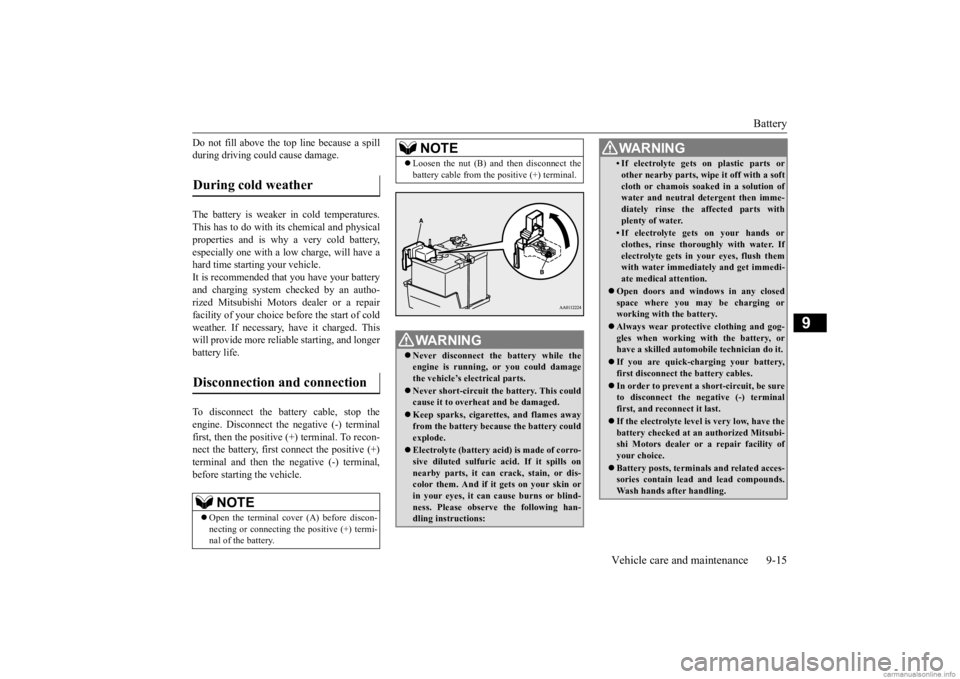
Battery
Vehicle care and maintenance 9-15
9
Do not fill above the top line because a spill during driving could cause damage. The battery is weaker in cold temperatures. This has to do with it
s chemical and physical
properties and is why a very cold battery, especially one with a low charge, will have a hard time starting your vehicle. It is recommended th
at you have your battery
and charging system checked by an autho-rized Mitsubishi Motors dealer or a repair facility of your choice
before the start of cold
weather. If necessary, have it charged. Thiswill provide more reliab
le starting, and longer
battery life. To disconnect the battery cable, stop the engine. Disconne
ct the negative (-) terminal
first, then the positive
(+) terminal. To recon-
nect the battery, first
connect the positive (+)
terminal and then the negative (-) terminal, before starting the vehicle.During cold weather Disconnection and connection
NOTE
Open the terminal cover (A) before discon- necting or connecting the positive (+) termi- nal of the battery.
Loosen the nut (B) and then disconnect the battery cable from the positive (+) terminal.WA R N I N G Never disconnect the battery while the engine is running, or you could damage the vehicle’s electrical parts. Never short-circuit the battery. This could cause it to overheat and be damaged. Keep sparks, cigarette
s, and flames away
from the battery because the battery couldexplode. Electrolyte (battery ac
id) is made of corro-
sive diluted sulfuric acid. If it spills on nearby parts, it can crack, stain, or dis- color them. And if it gets on your skin orin your eyes, it can cause burns or blind- ness. Please observe the following han- dling instructions:NOTE
• If electrolyte gets
on plastic parts or
other nearby parts, wi
pe it off with a soft
cloth or chamois soak
ed in a solution of
water and neutral detergent then imme- diately rinse the affected parts with plenty of water.• If electrolyte gets on your hands orclothes, rinse thoroughly with water. Ifelectrolyte gets in your eyes, flush them with water immediat
ely and get immedi-
ate medical attention.
Open doors and wind
ows in any closed
space where you may be charging orworking with the battery. Always wear protecti
ve clothing and gog-
gles when working with the battery, or have a skilled automobi
le technician do it.
If you are quick-charging your battery, first disconnect the battery cables. In order to prevent a short-circuit, be sure to disconnect the
negative (-) terminal
first, and reconnect it last. If the electrolyte level is very low, have the battery checked at an
authorized Mitsubi-
shi Motors dealer or
a repair facility of
your choice. Battery posts, termin
als and related acces-
sories contain lead and lead compounds. Wash hands after handling.WA R N I N G
BK0278200US.book 15 ページ 2019年4月10日 水曜日 午前10時59分
Page 392 of 443

Tires
Vehicle care and maintenance 9-19
9
EXAMPLE: DOT MA L9 ABCD 1504
The treadwear grade is a comparative rating based on the wear rate of thetire when tested under controlled conditions on a specified government test course. For example, a tiregraded 150 would wear one and one- half (1
1/2) times as well on the gov-
ernment course as a tire graded 100. The relative performance of tires depends upon the actual conditionsof their use, however, and may depart significantly from the norm due to variations in driving habits, servicepractices and differences in road characteristics and climate. The traction grades, from highest to lowest, are AA, A, B and C. Those grades represent the tire’s ability to stop on wet pavement as measured
under controlled conditions on speci- fied government test surfaces of asphalt and concrete. A tire marked C may have poor traction perfor-mance. The temperature grades are A (the highest), B and C, representing thetire’s resistance to the generation of heat and its ability to dissipate heat when tested under controlled condi-tions on a specified indoor laboratory test wheel. Sustained high tempera- ture can cause the material of the tireto degenerate and reduce tire life, and excessive temperature can lead to sudden tire failure. The grade C cor-responds to a level of performance which all passenger car tires must meet under the Federal Motor Vehi-cle Safety Standard No. 109. GradesB and A represent higher levels of performance on the laboratory test wheel than the minimum required bylaw.
DOT
Department of Transporta- tion This symbol certifies that the tire is in compliance with the U.S. Department of Transportation tire safety standards, and is approved for highway use.
MA
Code representing the tire manufacturing location. (2 digits)
L9 ABCD
Code representing the tire size. (2 digits) Code used by tire manufac-turer. (1 to 4 digits)
15
Number representing the week in which the tire was manufactured. (2 digits)
04
Number representing the year in which the tire was manufactured. (2 digits)
Treadwear, Traction and Temper-ature Grades Treadwear Tr a c t i o n
Temperature
BK0278200US.book 19 ページ 2019年4月10日 水曜日 午前10時59分
Page 393 of 443
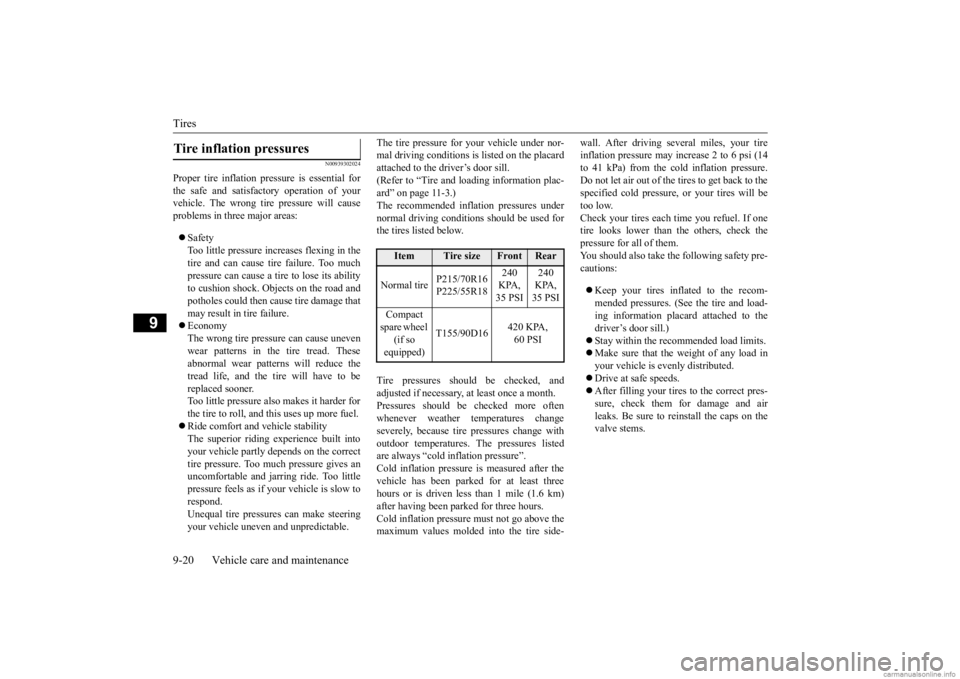
Tires 9-20 Vehicle care and maintenance
9
N00939302024
Proper tire inflation pres
sure is essential for
the safe and satisfactory operation of your vehicle. The wrong tire
pressure will cause
problems in three major areas: Safety Too little pressure increases flexing in the tire and can cause tire failure. Too much pressure can cause a tire to lose its ability to cushion shock. Objects on the road andpotholes could then cause tire damage that may result in tire failure. Economy The wrong tire pressure can cause uneven wear patterns in the tire tread. These abnormal wear patterns will reduce thetread life, and the tire will have to be replaced sooner. Too little pressure also makes it harder forthe tire to roll, and this uses up more fuel. Ride comfort and vehicle stability The superior riding
experience built into
your vehicle partly depends on the correct tire pressure. Too mu
ch pressure gives an
uncomfortable and ja
rring ride. Too little
pressure feels as if your vehicle is slow to respond. Unequal tire pressures can make steeringyour vehicle uneven and unpredictable.
The tire pressure for your vehicle under nor- mal driving conditions is listed on the placardattached to the driver’s door sill. (Refer to “Tire and loading information plac- ard” on page 11-3.)The recommended infl
ation pressures under
normal driving conditions should be used for the tires listed below. Tire pressures should be checked, and adjusted if necessary, at least once a month. Pressures should be checked more often whenever weather temperatures changeseverely, becaus
e tire pressures change with
outdoor temperatures. The pressures listed are always “cold inflation pressure”.Cold inflation pressure is measured after the vehicle has been parked
for at least three
hours or is driven less than 1 mile (1.6 km)after having been parked for three hours. Cold inflation pressure must not go above the maximum values molded into the tire side-
wall. After driving seve
ral miles, your tire
inflation pressure may increase 2 to 6 psi (14to 41 kPa) from the cold inflation pressure. Do not let air out of the tires to get back to the specified cold pressure, or your tires will betoo low. Check your tires each time you refuel. If one tire looks lower than the others, check thepressure for all of them. You should also take the following safety pre- cautions: Keep your tires inflated to the recom- mended pressures. (See the tire and load- ing information placard attached to thedriver’s door sill.) Stay within the recommended load limits. Make sure that the weight of any load in your vehicle is evenly distributed. Drive at safe speeds. After filling your tires to the correct pres- sure, check them for damage and air leaks. Be sure to reinstall the caps on the valve stems.
Tire inflation pressures
Item
Tire size
Front
Rear
Normal tire
P215/70R16 P225/55R18
240 KPA, 35 PSI
240 KPA, 35 PSI
Compact spare wheel
(if so equipped)
T155/90D16
420 KPA, 60 PSI
BK0278200US.book 20 ページ 2019年4月10日 水曜日 午前10時59分
Page 400 of 443
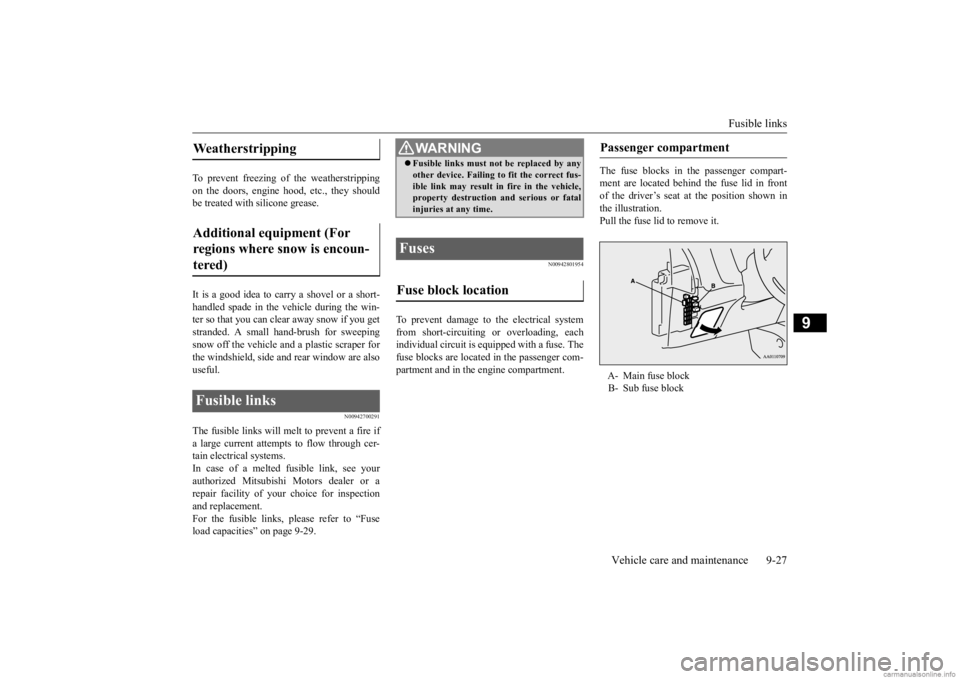
Fusible links
Vehicle care and maintenance 9-27
9
To prevent freezing of the weatherstripping on the doors, engine hood, etc., they should be treated with
silicone grease.
It is a good idea to carry a shovel or a short- handled spade in the vehicle during the win-ter so that you can clear away snow if you get stranded. A small hand-brush for sweeping snow off the vehicle a
nd a plastic scraper for
the windshield, side a
nd rear window are also
useful.
N00942700291
The fusible links will melt to prevent a fire ifa large current attempts to flow through cer- tain electrical systems.In case of a melted fusible link, see your authorized Mitsubishi Motors dealer or a repair facility of your choice for inspectionand replacement. For the fusible links, please refer to “Fuse load capacities” on page 9-29.
N00942801954
To prevent damage to the electrical systemfrom short-circuiting or
overloading, each
individual circuit
is equipped with a fuse. The
fuse blocks are located in the passenger com- partment and in the engine compartment.
The fuse blocks in the passenger compart- ment are located behind the fuse lid in front of the driver’s seat at the position shown in the illustration.Pull the fuse lid to remove it.
Weatherstripping Additional equipment (For regions where snow is encoun- tered) Fusible links
WA R N I N G Fusible links must not be replaced by any other device. Failing to fit the correct fus-ible link may result in fire in the vehicle,property destruction and serious or fatal injuries at any time.
Fuses Fuse block location
Passenger compartment A- Main fuse block B- Sub fuse block
BK0278200US.book 27 ページ 2019年4月10日 水曜日 午前10時59分
Page 402 of 443

Fuses
Vehicle care and maintenance 9-29
9
N00954801430
This fuse list shows the names of the elec
trical systems and their fuse capacities.
There are spare fuses in the main fuse block cover in the engine
compartment. Always replace a bl
own fuse with one of the same
capacity as the
original.Fuse load capacities Passenger compartment
fuse location table
Main fuse block
Sub fuse block
No.
Sym- bol
Electrical system
Capacity
1
Power window con-
trol
30 A*
2 Defogger 30 A*
3 Heater 30 A 4 Windshield wipers 30 ANo.
Sym- bol
Electrical system
Capacity
5 Door locks 20 A 6 Rear fog light 10 ANo.
Sym- bol
Electrical system
Capacity
BK0278200US.book 29 ページ 2019年4月10日 水曜日 午前10時59分
Page 415 of 443

Vehicle care precautions 9-42 Vehicle care and maintenance
9
N00943900102 N00945100166
In order to maintain the value of your vehicle, perform regular maintenance using the proper materials and procedures
. Be sure to use only
those materials and proc
edures that meet your
local environmental pollution control regula- tions. Choose the material
s you will use care-
fully, to be sure that they do not contain corrosives. If you are not sure, contact an authorized Mitsubishi Mo
tors dealer for help
in choosing these materials.
These can all be danger
ous, and they all can
damage your vehicle.
N00945200095
After washing the inside
of your vehicle with
any cleaner, wipe it dry in a shady, well venti- lated area.
N00945300155
1. Lightly wipe these off with a soft clothsoaked in a 3% solution of gentle soap and water. 2. To rinse, dip the cloth in fresh water,wring it out well, a
nd wipe off all the
soap.
High-mounted stop light
NOTE
The high-mounted stop light uses an LED instead of the bulb. Check with an authorizedMitsubishi Motors dealer
or a repair facility
of your choice when the light needs to be repaired or replaced.
Vehicle care precautions
CAUTION Cleaning products can be dangerous. Some are poisonous and others
are highly flamma-
ble. Some are dangerous if you breathe theirfumes in a closed sp
ace. When you use any-
thing in a container to
clean your vehicle, be
sure to follow the in
structions. Always open
your vehicle doors or windows when you’re cleaning the inside. Never use the following chemicals to clean your vehicle:• Gasoline• Carbon Tetrachloride• Benzine• Kerosene• Naphtha• Acetone• Turpentine• Paint Thinner• Lacquer Thinner• Nail Polish Remover
Cleaning the inside of your vehicle
CAUTION Do not use organic substances (solvents, benzine, kerosene, alc
ohol, gasoline, etc.) or
alkaline or acidic solutions.These chemicals can cause discoloring, staining or cracking of the surface. If you use cleaners or polishing agents, makesure their ingredients do not include the sub- stances mentioned above.NOTE
Always read the instru
ctions on the cleaner
label.
Plastic, vinyl leather, fabric and flocked parts
BK0278200US.book 42 ページ 2019年4月10日 水曜日 午前10時59分
Page 417 of 443
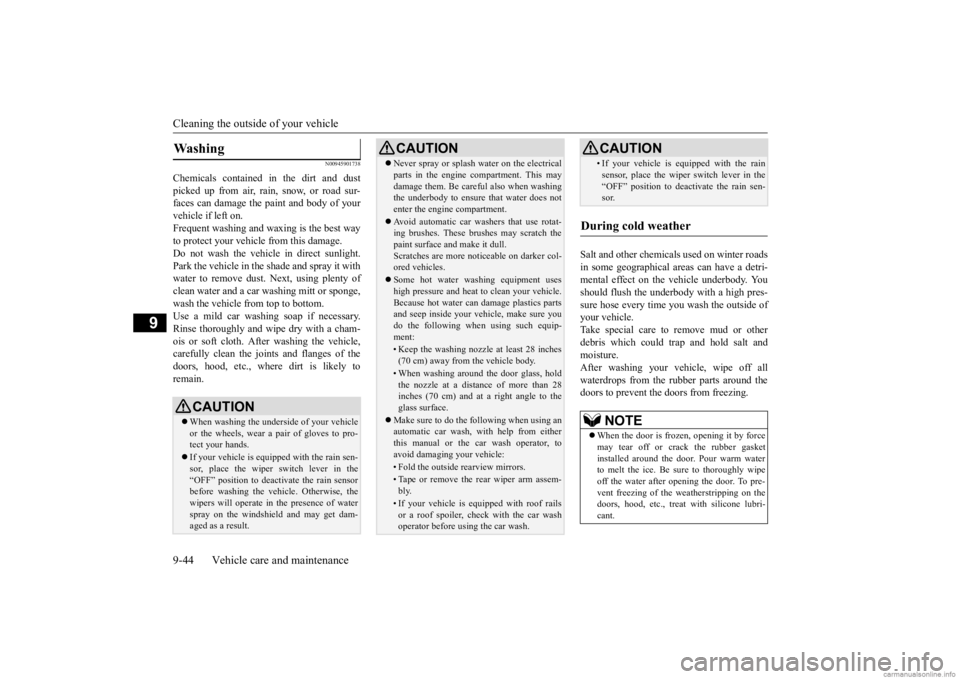
Cleaning the outside of your vehicle 9-44 Vehicle care and maintenance
9
N00945901738
Chemicals cont
ained in the dirt and dust
picked up from air, rain, snow, or road sur- faces can damage the paint and body of yourvehicle if left on. Frequent washing and wa
xing is the best way
to protect your vehicl
e from this damage.
Do not wash the vehicle in direct sunlight. Park the vehicle in the shade and spray it with water to remove dust.
Next, using plenty of
clean water and
a car washing mitt or sponge,
wash the vehicle from top to bottom.Use a mild car washing soap if necessary. Rinse thoroughly and wipe dry with a cham- ois or soft cloth. After washing the vehicle,carefully clean the joints and flanges of the doors, hood, etc., wher
e dirt is likely to
remain.
Salt and other chemical
s used on winter roads
in some geographical ar
eas can have a detri-
mental effect on the vehicle underbody. You should flush the underbody with a high pres- sure hose every time you wash the outside ofyour vehicle. Take special care to
remove mud or other
debris which could trap and hold salt andmoisture. After washing your vehicle, wipe off all waterdrops from the rubber parts around thedoors to prevent the doors from freezing.
Wa s h i n g
CAUTION When washing the underside of your vehicle or the wheels, wear a pair of gloves to pro- tect your hands. If your vehicle is equippe
d with the rain sen-
sor, place the wiper switch lever in the“OFF” position to deacti
vate the rain sensor
before washing the vehi
cle. Otherwise, the
wipers will operate in
the presence of water
spray on the windshield and may get dam- aged as a result.
Never spray or splash
water on the electrical
parts in the engine compartment. This maydamage them. Be careful also when washingthe underbody to ensure that water does not enter the engine compartment. Avoid automatic car washers that use rotat- ing brushes. These brushes may scratch the paint surface and make it dull.Scratches are more not
iceable on darker col-
ored vehicles. Some hot water wash
ing equipment uses
high pressure and heat to clean your vehicle. Because hot water can da
mage plastics parts
and seep inside your ve
hicle, make sure you
do the following when using such equip- ment:• Keep the washing nozzle at least 28 inches(70 cm) away from the vehicle body.• When washing around the door glass, holdthe nozzle at a distance of more than 28inches (70 cm) and at a right angle to the glass surface.
Make sure to do the following when using an automatic car wash, with help from either this manual or the car wash operator, toavoid damaging your vehicle:• Fold the outside rearview mirrors.• Tape or remove the rear wiper arm assem-bly.• If your vehicle is equipped with roof railsor a roof spoiler, check with the car washoperator before using the car wash.CAUTION
• If your vehicle is equipped with the rainsensor, place the wiper switch lever in the“OFF” position to deac
tivate the rain sen-
sor.
During cold weather
NOTE
When the door is frozen, opening it by force may tear off or crack the rubber gasketinstalled around the door. Pour warm water to melt the ice. Be sure to thoroughly wipe off the water after opening the door. To pre-vent freezing of the we
atherstripping on the
doors, hood, etc., treat with silicone lubri- cant.CAUTION
BK0278200US.book 44 ページ 2019年4月10日 水曜日 午前10時59分